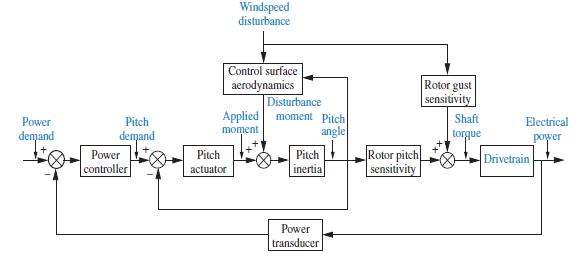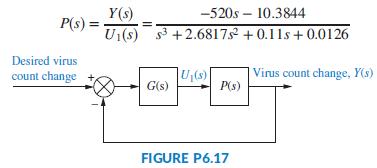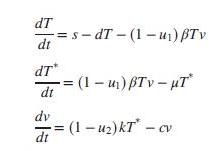In the linearized model of Chapter 6, Problem68, where virus levels are controlled by means of RTIs,
Question:
In the linearized model of Chapter 6, Problem68, where virus levels are controlled by means of RTIs, the open-loop plant transfer function was shown to be

The amount of RTIs delivered to the patient will automatically be calculated by embedding the patient in the control loop as G(s) shown in Figure P6.17 (Craig, 2004).
a. In the simplest case, G(s) = K, with K > 0. Note that this effectively creates a positive-feedback loop because the negative sign in the numerator of P(s) cancels out with the negative-feedback sign in the summing junction. Use positive-feedback rules to plot the root locus of the system.
b. Now assume G(s) = -K with K > 0. The system is now a negative feedback system. Use negative-feedback rules to draw the root locus. Show that in this case the system will be closed-loop stable for all K > 0.
a.

b.

c.

FIGURE P8.17 a. Wind turbines generating electricity near Palm Springs, California; b. control loop for a constant-speed pitch-controlled wind turbine;5 c. drivetrain5
Data From Chapter 6, Problem 68:
The HIV infection linearized model developed in Problem 84,Chapter 4, can be shown to have the transfer function

It is desired to develop a policy for drug delivery to maintain the virus count at prescribed levels. For the purpose of obtaining an appropriate u1(t); feedback will be used as shown in Figure P6.17 (Craig, 2004). As a first approach, consider G(s) = K; a constant to be selected. Use the Routh-Hurwitz criteria to find the range of K for which the system is closed-loop stable.

Data from Problem 84,Chapter 4:
We developed a linearized state-space model of HIV infection. The model assumed that two different drugs were used to combat the spread of the HIV virus. Since this book focuses on single-input, single output systems, only one of the two drugs will be considered. We will assume that only RTIs are used as an input. Thus, in the equations of Chapter 3, Problem 31, u2 = 0 (Craig, 2004).
a. Show that when using only RTIs in the linearized system of Problem 31, Chapter 3, and substituting the typical parameter values given in the table of Problem 31c, Chapter 3, the resulting state-space representation for the system is given by

b. Obtain the transfer function from RTI efficiency to virus count; namely, find Y(s)/U1(s).
c. Assuming RTIs are 100% effective, what will be the steady-state change of virus count in a given infected patient? Express your answer in virus copies per ml of plasma. Approximately how much time will the medicine take to reach its maximum possible effectiveness?
Data from Chapter 3, Problem 31:

Step by Step Answer:





